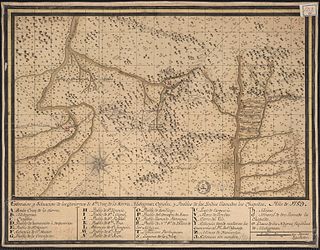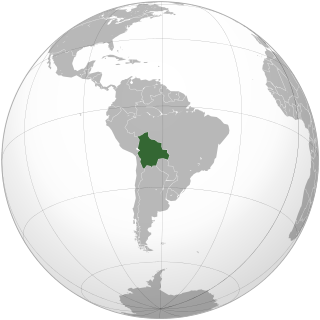
Chiquitania is a region of tropical savannas in the Santa Cruz Department in eastern Bolivia.

Chuquisaca is a department of Bolivia located in the center south. It borders on the departments of Cochabamba, Tarija, Potosí, and Santa Cruz. The departmental capital is Sucre, which is also the constitutional capital of Bolivia.

Some of the regional varieties of the Spanish language are quite divergent from one another, especially in pronunciation and vocabulary, and less so in grammar.

In Spanish grammar, voseo is the use of vos as a second-person singular pronoun, along with its associated verbal forms, in certain regions where the language is spoken. In those regions it replaces tuteo, i.e. the use of the pronoun tú and its verbal forms. Voseo can also be found in the context of using verb conjugations for vos with tú as the subject pronoun.

Rioplatense Spanish, also known as Rioplatense Castilian, River Plate Spanish, or Argentine Spanish, is a variety of Spanish originating in and around the Río de la Plata Basin, and now spoken throughout most of Argentina and Uruguay. It is the most prominent dialect to employ voseo in both speech and writing. Many features of Rioplatense are also shared with the varieties spoken in south and eastern Bolivia, and Paraguay. This dialect is often spoken with an intonation resembling that of the Neapolitan language of Southern Italy, but there are exceptions.

Macro-Jê is a medium-sized language family in South America, mostly in Brazil but also in the Chiquitanía region in Santa Cruz, Bolivia, as well as (formerly) in small parts of Argentina and Paraguay. It is centered on the Jê language family, with most other branches currently being single languages due to recent extinctions.

Sud Chichas is a province in the Bolivian department of Potosí. Its seat is Tupiza.

Chilean Spanish is any of several varieties of the Spanish language spoken in most of Chile. Chilean Spanish dialects have distinctive pronunciation, grammar, vocabulary, and slang usages that differ from those of Standard Spanish. Formal Spanish in Chile has recently incorporated an increasing number of colloquial elements.

Cuban Spanish is the variety of the Spanish language as it is spoken in Cuba. As a Caribbean variety of Spanish, Cuban Spanish shares a number of features with nearby varieties, including coda weakening and neutralization, non-inversion of Wh-questions, and a lower rate of dropping of subject pronouns compared to other Spanish varieties. As a variety spoken in Latin America, it has seseo and lacks the vosotros pronoun.

Spanish is the language that is predominantly understood and spoken as a first or second language by nearly all of the population of Argentina. According to the latest estimations, the population is currently greater than 45 million.
Chiquitano is an indigenous language isolate spoken in the central region of Santa Cruz Department of eastern Bolivia and the state of Mato Grosso in Brazil.

Colombian Spanish is a grouping of the varieties of Spanish spoken in Colombia. The term is of more geographical than linguistic relevance, since the dialects spoken in the various regions of Colombia are quite diverse. The speech of the northern coastal area tends to exhibit phonological innovations typical of Caribbean Spanish, while highland varieties have been historically more conservative. The Caro and Cuervo Institute in Bogotá is the main institution in Colombia to promote the scholarly study of the language and literature of both Colombia and the rest of Spanish America. The educated speech of Bogotá, a generally conservative variety of Spanish, has high popular prestige among Spanish-speakers throughout the Americas.

Costa Rican Spanish is the form of the Spanish language spoken in Costa Rica. It is one of the dialects of Central American Spanish. Nevertheless, because the country was more remote than its neighbors, the development of this variety of Spanish followed a distinct path.

Nicaraguan Spanish is geographically defined as the form of Spanish spoken in Nicaragua. Affectionately, Nicaraguan Spanish is often called Nicañol.

Paraguayan Spanish is the set of dialects of the Spanish language spoken in Paraguay. In addition, it influences the speech of the Argentine provinces of Misiones, Corrientes, Formosa, and, to a lesser extent, Chaco. Paraguayan Spanish possesses marked characteristics of the Spanish previously spoken in northern Spain, because a majority of the first Spanish settlers were from Old Castile and the Basque Country. In addition, there is great influence, in both vocabulary and grammar, from the Guarani language. Guarani is co-official with Spanish in Paraguay, and most Paraguayans speak both languages. Guaraní is the home language of more than half the population of Paraguay, with higher proportions of its use in rural areas, and those who speak Spanish at home slightly in the majority in the cities. In addition to the strong influence of Guarani, Paraguayan Spanish is also influenced by Rioplatense Spanish due to the geographical, historical, and cultural proximity, as well as the sharing of features such as voseo, which is "the use of vos as a second-person singular pronoun." Paraguayan Spanish is notable for its lack of yeísmo, meaning that the phonemes /ʎ/ and /ʝ/ are distinguished.

Salvadoran Spanish is geographically defined as the form of Spanish spoken in the country of El Salvador. The Spanish dialect in El Salvador shares many similarities to that of its neighbors in the region, but it has its stark differences in pronunciation and usage. El Salvador, like most of Central America, uses voseo Spanish as its written and spoken form, similar to that of Argentina. Vos is used, but many Salvadorans understand tuteo. Vos can be heard in television programs and can be seen in written form in publications. Usted is used as a show of respect, when someone is speaking to an elderly person.

Andean Spanish is a dialect of Spanish spoken in the central Andes, from southern Colombia, with influence as far south as northern Chile and Northwestern Argentina, passing through Ecuador, Peru, and Bolivia. While similar to other Spanish dialects, Andean Spanish shows influence from Quechua, Aymara, and other indigenous languages, due to prolonged and intense language contact. This influence is especially strong in rural areas.
The Pauna language, Paunaka, is an Arawakan language in South America. It is an extremely endangered language, which belongs to the southern branch of the Arawakan language family and it is spoken in the Bolivian area of the Chiquitanía, near Santa Cruz and north of the Chaco region. The suffix -ka is a plural morpheme of the Chiquitano language, but has been assimilated into Pauna.

Spanish is the most-widely spoken language in Ecuador, though great variations are present depending on several factors, the most important one being the geographical region where it is spoken. The three main regional variants are:

Peruvian Spanish is a family of dialects of the Spanish language that have been spoken in Peru since brought over by Spanish conquistadors in 1532. There are five varieties spoken in the country, by about 94.4% of the population. The five Peruvian dialects are Andean Spanish, Peruvian Coastal Spanish, Andean-Coastal Spanish, Equatorial Spanish, and Amazonic Spanish.












